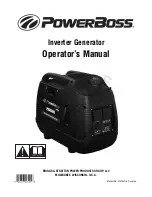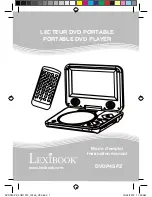
12
www.1800generator.com.au
NOTICE
• DO NOT connect 3-phase loads to the generator.
• DO NOT connect 60 Hz loads to the generator.
• DO NOT OVERLOAD THE GENERATOR. See
Don’t
Overload Generator
.
NOTICE
Exceeding generators wattage/amperage capacity
could damage generator and/or electrical devices connected
to it.
• DO NOT exceed the generator’s wattage / amperage capacity. See
Don’t Overload Generator
in the
Operation
section.
• Start generator and let engine stabilize before connecting
electrical loads.
• Connect electrical loads in OFF position, then turn ON for
operation.
• Turn electrical loads OFF and disconnect from generator before
stopping generator.
Stopping the Engine
1. Turn OFF and unplug all electrical loads from generator
panel receptacles. NEVER start or stop engine with
electrical devices plugged in and turned ON.
2. Move POWERSMART switch to “
Off or O
” position.
3. Let engine run at no-load for several minutes to
stabilize internal temperatures of engine and generator.
4. Turn engine switch to the “
Off or O
” position.
5. Turn fuel cap vent lever to the “
Off or O
” position.
POWERSMART Mode
This feature is designed to greatly improve fuel economy.
When this switch is turned ON
, the engine speed will
increase as electrical loads are connected, and decreased as
electrical loads are removed.
With the switch off
, the engine will run at full governed
speed.
Always have the switch OFF when starting and
stopping the engine.
NOTICE
Always have the switch OFF when starting or
stopping the generator or when using the DC receptacle.
Charging a Battery
Your generator has the capability of recharging a discharged
12 Volt automotive or utility style storage battery.
NOTICE
• Not for use with any other type of battery.
• DO NOT use the unit to charge any 6 Volt batteries.
• DO NOT use the unit to crank an engine having a
discharged battery.
To recharge 12 Volt batteries, proceed as follows:
1. If necessary, clean battery posts or terminals.
2. Check fluid level in all battery cells. If necessary, add
ONLY distilled water to cover separators in battery
cells.
DO NOT use tap water.
3. If the battery is equipped with vent caps, make sure
they are installed and are tight.
4. Connect battery charge cable clamp with
red
handle to
battery post or terminal indicated by
Positive
,
POS
or (
+
).
5. Connect battery charge cable clamp with
black
handle to
battery post or terminal indicated by
Negative
,
NEG
, or (
–
).
6. Connect battery charge cable connector plug to the
12 Volt DC panel receptacle.
7. Start generator as described in
Starting The Engine
. Let
the engine run while battery recharges.
NOTICE
Normally a period of 30 to 120 minutes is
sufficient to recharge a weak battery.
8. When battery has charged, shut down engine as
described in
Stopping The Engine
.
9. Remove the battery charging cable from the generator
and then disconnect from the battery posts.
NOTICE
Use an automotive hydrometer to test battery state of
charge and condition. Follow the hydrometer manufacturer’s
instructions carefully. Generally, a battery is considered to be at
100% state of charge when specific gravity of its fluid (as
measured by hydrometer) is 1.260 or higher.
WARNING
Generator voltage could cause electrical
shock or burn resulting in death or serious
injury.
• DO NOT connect generator to a building’s electrical system.
• DO NOT touch bare wires or receptacles.
• DO NOT use generator with electrical cords which are worn,
frayed, bare or otherwise damaged.
• DO NOT operate generator in the rain or wet weather.
• DO NOT handle generator or electrical cords while standing in
water, while barefoot, or while hands or feet are wet.
• DO NOT allow unqualified persons or children to operate or
service generator.
WARNING
Storage batteries give off explosive
hydrogen gas during recharging.
Hydrogen gas stays near battery for a
long time after battery has been
charged. Slightest spark could ignite hydrogen causing
explosion resulting in death, serious injury and/or
property damage.
Battery electrolyte fluid contains acid and is extremely
caustic. Contact with battery fluid could cause chemical
burns resulting in serious injury and/or property damage.
• DO NOT allow any open flame, spark, heat, or lit cigarette
during and for several minutes after charging a battery.
• Wear protective goggles, rubber apron, and rubber gloves.
• DO NOT continue to charge a battery that becomes hot or is
fully charged.
• DO NOT leave battery unattended.
Not
for
Reproduction










































